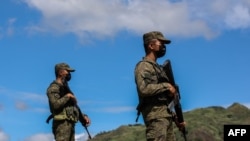An unusually large joint military exercise being held by the United States and the Philippines answers what Manila regards as a growing threat from China, according to some analysts.
U.S. military personnel joined troops from the Philippines on Monday for scheduled exercises called Balikatan, meaning “shoulder to shoulder.” A U.S. defense official called it the largest ever with 3,800 Philippine participants and 5,100 from the United States.
Philippine President Rodrigo Duterte has pivoted toward the United States over the past two years after attempting a friendship with China.
China offered billions of dollars in development aid to the relatively impoverished Southeast Asian country, but it used its military, the world’s third largest, to keep up pressure on disputed islets and contested tracts of sea between the two nations.
This year’s Balikatan shores up a Philippine-U.S. military alliance that began with a mutual defense treaty in 1951 and grew with a visiting forces agreement inked in 1999. Duterte had threatened to scrap the 1999 deal as he grew closer to Beijing but agreed last year to keep the deal in place.
“The U.S. consistently valued and embraced the relationship, and so I think that also had some effect on Duterte’s thinking,” said Alexander Vuving, a professor at the Daniel K. Inouye Asia-Pacific Center for Security Studies, in Hawaii.
He called the Philippines a “swing state in the Indo-Pacific” and said it’s swinging toward the U.S. side to ensure access to the South China Sea, a source of fish and energy reserves.
Philippines-China tensions
In March and April 2021, Manila fumed when more than 220 Chinese boats moored off a South China Sea reef that’s disputed by the two countries. It protested, too, against a Chinese research vessel that stayed for three days earlier this year in the Sulu Sea near the Philippines.
Chinese and Philippine officials exchanged competing claims of sovereignty this week over the South China Sea’s fishery-rich Scarborough Shoal after Manila cited a “violation” by a passing Chinese coast guard vessel.
Chinese officials point to historic records as support for their claim to about 90% of the 3.5 million-square-kilometer South China Sea, while the Philippines cites a United Nations convention. Brunei, Malaysia, Taiwan and Vietnam claim all or parts of the sea, which is valued for fisheries, fossil fuel reserves and marine shipping lanes.
Crisis planning
The exercises are scheduled to cover amphibious landings, airstrikes and ship movements at two locations before ending April 8, the Armed Forces of the Philippines said via Facebook. Humanitarian work is also on the agenda.
Balikatan “enhances crisis action planning and crisis response capability,” the U.S. defense official said.
The exercises are especially crucial if China plans to push the Philippines away from Scarborough Shoal, said Ramon Casiple, an independent political analyst based in Metro Manila. China had taken control of the South China Sea feature in 2012 after a two-month standoff.
“If the U.S. is going back to the region and making it an important affair, the Philippines will have something to stand on in the contested area,” Casiple said. “The Philippines never conceded Scarborough Shoal to the Chinese.”
The U.S. government has counted the Philippines as one in a chain of Asia-Pacific allies and asked its old Cold War foe Beijing to keep the South China Sea open for international use.
Balikatan is going on per schedule but comes at a time when both Manila and Washington have things to prove, said Aaron Rabena, research fellow at the Asia-Pacific Pathways to Progress Foundation in Metro Manila. “These things, they’re for … I think, territorial posturing, and it coincides with Russia’s invasion of Ukraine,” Rabena noted.
U.S. officials oppose Russia’s war in Ukraine and have kept a wary eye on China as a Russian ally.
Chinese state-monitored media outlet the Global Times said Sunday that the U.S. and Philippine armed forces were conducting “extensive drills with new tactics” to “contain China” against the rapid development of the Chinese People's Liberation Army.
Filipinos are watching their relations with the United States ahead of a May 9 presidential election, Casiple said. Duterte must step down because of term limits.
Ferdinand Marcos Jr., son of ex-President Ferdinand Marcos, is leading other candidates, according to a February survey by the polling agency Pulse Asia. He has called China a “friend” and domestic media report that he has advocated setting aside a 2016 world arbitration court decision that rejects the legal basis for Beijing’s claims to the South China Sea.
Filipinos don’t normally select presidential candidates based on foreign policy statements, and Marcos has not said he would reject the United States in favor of China, even if he pursues friendly relations with Beijing.
The annual exercise between the U.S. and the Philippines was canceled because of the pandemic in 2020 and was scaled back last year.
Editor’s note: An earlier version of this story had a headline that incorrectly referred to China. It should have said: Why US, Philippines Are Staging Large-Scale Military Exercises.







